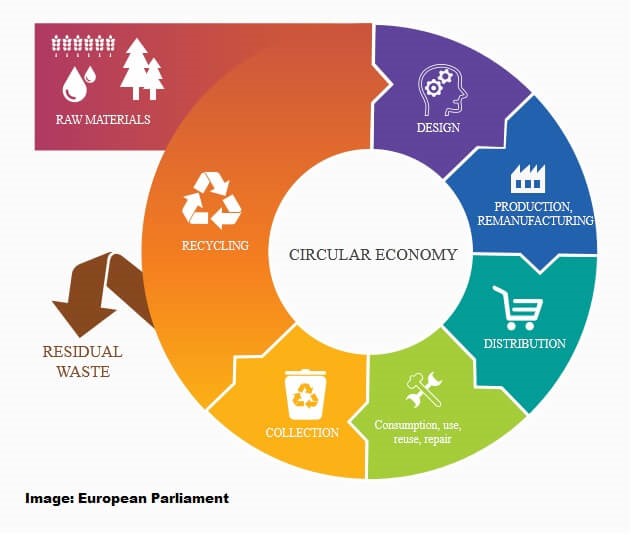As the threat of climate change becomes more imminent- with recent scientific studies declaring the year 2040 as an ultimatum for preventative action to be taken- we must look to alternative models for sustainable lives.
studies declaring the year 2040 as an ultimatum for preventative action to be taken- we must look to alternative models for sustainable lives.
One such model is a circular economy. In contrast to the traditional “linear economy”- in which raw materials are used for production of goods, generating waste with leftover materials- the circular economy redefines economic growth. With societal and environmental benefits at the center of the model, it seeks to eliminate waste and pollution as byproducts of production processes. The status quo formula of “take, make, dispose” has had detrimental ecological effects and can be bypassed using the circular model. Additionally, a circular economy is designed to keep materials in circulation, using them to their maximum capabilities. This creates a positive feedback loop in which outputs are used to amplify the production process continuously.
Sustainable development fosters economic growth and benefits the companies that use it. If the use of materials remains in circulation for longer, there is less need for continuous resource extraction, thereby reducing total costs of production. Such sustainable development is beneficial to both the supply and demand sides of the market. The question remains, though: can firms continue to increase profitability while cutting back on natural resource usage? Consulting giants such as McKinsey believe that circularity is, at the very least, a step in the right direction. A 2015 study done with the Ellen MacArthur Foundation showed that circular development would generate savings of €600 billion annually and would increase European resource productivity by nearly three percent within the next decade.
The concept of a circular economy is still a relatively new one. In 2015, the European Commission implemented the Circular Economy Action Plan. The plan facilitates a shift towards circularity, establishes global competition, and stimulates sustainable economic growth. Nearly four years after its inception, the plan is complete. This includes fifty-four actions to change product life-cycles. Among these, plastics, biomass, and food waste have been designated as “priority sectors” to expedite the transition process.
Japan has also begun the transition to a circular economy. In 2000, the Law for the Promotion of Efficient Utilization of Resources defined materials as circular goods and mandated that manufacturers must run disassembly plants to recover materials. As more nations begin to turn towards circularity, it is essential that large carbon emitting countries such as the US, China, and India, follow in their path. We are beginning to see progress from China and India, signing onto deals with the EU to be implemented within the next decade or so. Nevertheless, there is still a distance to go.
Despite its numerous benefits, there are several issues with circularity. For instance, the definition is still rather vague and misunderstood. Stakeholders seem to hold differing expectations of its future, and thus, common ground for debate can be difficult to find. From a practicality standpoint, questions still linger about the feasibility of closing material cycles completely. The process of recycling materials still requires a legitimate amount of energy. Granted, this is still a reduction of energy compared to that needed for resource extraction, but it nonetheless has the potential to create climate-related conflicts.
Profugo has been incorporating elements of the circular economic model in its development in Wayanad, India. The Natural Resources Management and Water for Life programs allow denizens of Wayanad to efficiently utilize their resources in an ecologically friendly manner. Working on a smaller scale allows us to circumvent the energy consumption challenges that large recycling plants face.
The growing trend towards circularity creates great potential for sustainable development. Business models based on these principles can have a vital impact on the advancement of economic systems and environmentally friendly growth. But it can’t grow on its own. Existing models can only reach their maximum capabilities if provided with the right structures.
References
“Circular Economy.” Circular Economy Strategy – Environment – European Commission, ec.europa.eu/environment/circular-economy/index_en.htm.
“Circular Economy: Definition, Importance and Benefits | News | European Parliament.” Circular Economy: Definition, Importance and Benefits | News | European Parliament, 10 Apr. 2018, www.europarl.europa.eu/news/en/headlines/economy/20151201STO05603/circular-economy-definition-importance-and-benefits.
“Climate Scientists to World: We Have Only 20 Years Before There’s No Turning Back.” NRDC, 17 May 2019, www.nrdc.org/onearth/climate-scientists-world-we-have-only-20-years-theres-no-turning-back.
“What Is a Circular Economy?” Ellen MacArthur Foundation, www.ellenmacarthurfoundation.org/circular-economy/concept.
“Why We Need a Circular Economy.” Zero Waste Scotland, 24 May 2017, www.zerowastescotland.org.uk/circular-economy/why-it-is-required.
Wilts H (2017) Key Challenges for Transformations Towards a Circular Economy – The Status Quo in Germany. Int J Waste Resour 7: 262. doi: 10.4172/2252-5211.1000262

Leave a Reply
You must be logged in to post a comment.